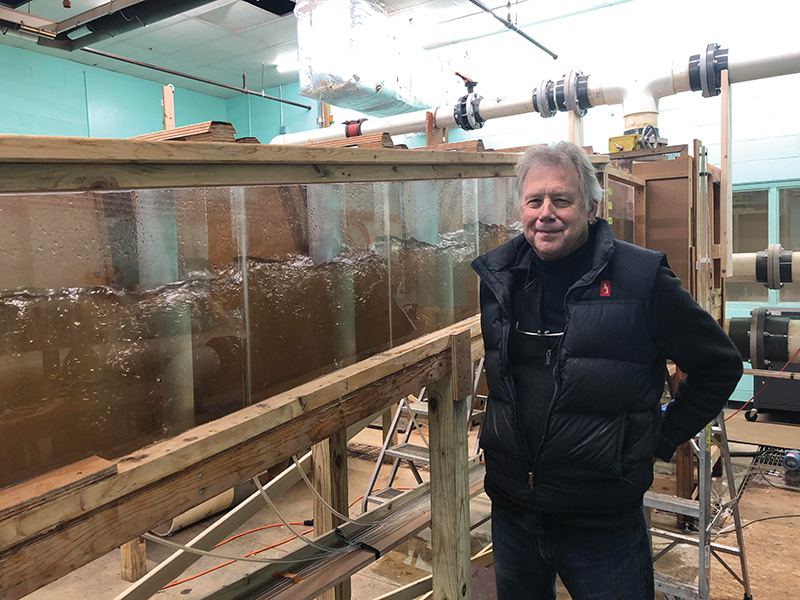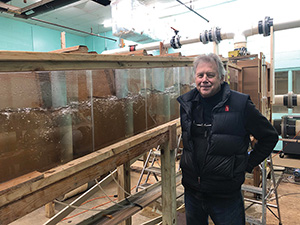
Dr. Alex Haro describes the small-scale model of a modification of the standard Denil fishway. Water is delivered from the pipes behind, and the Plexiglas walls allow scientists to observe and analyze the hydraulics of the design. Image Credit: Sally Harold.

Migrating Under a Microscope
The Conte Lab
By Steve Gephard and Sally Harold
Since their arrival in the 1600s, New Englanders have constructed fishways to help fish pass over small dams and barriers, but the early designs were rudimentary, often just a constructed gap. As engineering advanced and taller dams were built, the construction of fishways to allow migratory fish such as salmon and shad to move upstream became more challenging—and less successful. By the time some of the world’s largest dams were being built on the Connecticut River in the late 1700s, the engineering for successful fish passage just didn’t exist, and fish were left behind, restricted to downstream habitat. A leading factor in such failures was our lack of knowledge about how fish swim, migrate, and navigate obstacles. What was necessary was a laboratory dedicated to studying fish physiology, behavior, and ability.
That came nearly 200 years later in the form of the Silvio Conte Anadromous Fish Research Center (affectionately known as the Conte Lab), located in Turners Falls. Known to be one of the top fish research labs in the world, the lab specializes in the study of fish passage. It sits below the upper large power canal that feeds off the Turners Falls Dam and supplies water downstream to the Cabot Station Hydroelectric Station and above the lower Connecticut River. Its unique location means that water can gravity-feed from the canal, run down through the facility, and be released to the river below, all without pumps. Operated by the US Geological Survey, one of the lab’s main activities is testing both standard and experimental designs of fishways and fishway features (like entrances) on actively migrating fish. The 40,000-square-foot facility includes test flumes in a cavernous concrete building where the scientists can build full-scale versions of fishways, study tagged fish as they move through the fishways, make adjustments to designs, and retest.
The lab was built in 1991 and named after Congressman Silvio Conte, the same person for whom the four-state fish and wildlife refuge operated by the US Fish & Wildlife Service is named. Conte was a powerful committee chairman who lobbied tirelessly to direct federal dollars to his western Massachusetts home district. He was a committed conservationist and ardent supporter of the program to restore salmon, shad, and other migratory species to the Connecticut River. The lab has housed between 16 and 22 research scientists—biologists and engineers—and typically many students—often graduates and postgraduates—studying migratory fish. The lab employs world-renowned experts in fish physiology, fish behavior, and population dynamics, and these experts interact with scientists at other labs who specialize in genetics and fish health. Conte Lab scientists have collaborated with researchers across the country and in Brazil, China, Denmark, Germany, New Zealand, Norway, and Portugal. Recent work in Alaska and Antarctica has focused on climate change. Species that the researchers have studied include Atlantic Salmon, American Shad, Alewife, Blueback Herring, Rainbow Smelt, Striped Bass, Sea Lamprey, Sea Run Brook Trout, Shortnose Sturgeon, and Atlantic Sturgeon, as well as American Eel. Since the eel is catadromous, the lab should be the Conte DIADROMOUS Fish Research Center, but it was named before the restoration community began focusing on eels.

Left: Dr. Steve McCormick shows off a Shortnose Sturgeon that is kept in a circular tank in the facility’s wet lab. Right: Dr. Alex Haro stands in the middle of the main test flume of the lab with an experimental fishway under construction in the background. During tests, flowing water could be up to his waist or higher. Image Credit: Sally Harold
The current lab director is Dr. Brett Towler, an engineer with extensive expertise in fish passage. During a recent visit, he showed us a 1-to-4 scale model of an experimental fishway, which is a variation of an old design called a Denil. The model is about 20 feet long and 18 inches wide and has water flowing down it, but it is too small for fish to use. Brett explains that it is a proof-of-concept model for the hydraulic engineers to study, collect data, and fine tune before building a full-scale model out in the larger experimental flume. The three large flumes are a tinker’s dream. The two side flumes are 124 feet long and 10 feet wide. The main central flume is 125 feet by 20 feet. All three have the ability to pass a tremendous volume of Connecticut River water downstream and over weirs built by the engineers to mimic dams. At a depth of six feet of water, the side flume can deliver 350 cubic feet per second of water—more than, say, the Salmon River in Connecticut!
Brett explained that the experimental, small-scale Denil-like fishway that we saw in the adjacent lab is now being constructed in the main flume at full scale for spring testing. It has taken four months to construct, and they’re hurrying to get it ready for spring 2023 testing. Since they depend on actively migrating species that run up the Connecticut River in the spring, if they are not ready by springtime, they’ll have to wait until the spring of 2024. (As of press time, they were able to test this in May.) Typically, fish are collected from the Holyoke Dam Fishlift (at the next downstream dam), trucked to the lab and released into a large flow-through holding pen below the experimental flume. Before the trials, fish may be given a uniquely coded micro tag (like an EZ-Pass), which is entered into a database along with the fish’s species, size, sex, and age. When the tests are ready to be run, water is released down the experimental fishway, staff open the holding pen, and the fish move upstream, assuming they are resuming their interrupted migration. Receivers just like those at toll booths are located all along the fishway and as the fish ascend, data can be collected for each fish, including time of entry, time of exit, and total elapsed time. These data can be compared with water temperature, details on the individual fish, and manipulated aspects of the fishway such as slope, volume of water, water velocity, level of light, etc. Underwater cameras can capture video images of the fish moving up and physiologists can draw blood before and after the trials to study the impact of the effort to ascend the fishway on the fish’s bodies. All of these data and analyses can expand our understanding of how fish migrate and what fishway designs work best for each species.

A 2023 comparison test in a small flume: a standard Denil fishway is on the right, and an experimental modification of a Denil is on the left. Fish are offered a choice of which to ascend, and data are collected on all the fish in both fishways. Image Credit: Brett Towler
In some cases, the research may be used to determine what conditions will block the migration of fish. Dr. Alex Haro showed us an experiment that he set up in one of the side flumes, which was funded by the Great Lakes Fisheries Commission, which is spending enormous amounts of money to control the population of non-native Sea Lamprey in the lakes. The flume is lined with lights, cameras, and tag receivers, and Alex manipulates water velocities and the intensity of lights to determine if they can create instream conditions that will prevent Sea Lampreys from continuing upstream even without a dam. Alex is recently retired from the lab but continues to work in an emeritus status to complete some of his studies. When working with native Sea Lamprey on the East Coast, he and his colleagues at the lab study ways to improve passage for the species so their runs can be restored. But when dealing with the Great Lakes agencies, he studies ways to block their passage to support extirpation.
Another veteran researcher nearing retirement is Dr. Steve McCormick, who heads the Lab’s Physiology Section and has studied shad, alewives, and lamprey but is world renowned for his research on the physiology of salmon smolts, the down-running juveniles. Although the program to restore salmon to the Connecticut River has ended, Steve still studies salmon, and his work is valued by the folks in Maine and worldwide who are still engaged in salmon conservation.
The Conte lab is one of a kind in the US and one of a very few worldwide. Although its scope is not limited to the Connecticut River, professionals along the river and surrounding watersheds benefit from its location because our dams and streams often support field tests for the scientists’ work and our fish populations are often the first to benefit from that work. The first-class staff have served as invaluable resources to local students and fish passage practitioners. The two of us have worked on dam removal and fishway projects over many years and greatly value the contributions these folks have made to our projects. While the lab is not generally open to the public, it is a tremendous resource for the Connecticut River valley. When there is an open house or an invitation to visit, it’s an opportunity not to be missed!
Conte Lab Open House
There will be a rare opportunity to tour the lab this fall. The facility is hosting an open house on Saturday, October 14, 10 a.m. to 2 p.m. This will be the first such open house in many years. Scientists will be on hand to show the public around and discuss the ongoing projects.
The address is 1 Migratory way, Turners Falls, MA 01376.
For more information, call the lab at 413-863-9475.

